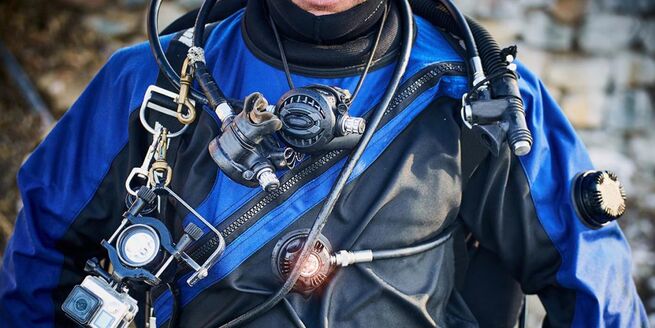When purchasing a new or replacement drysuit, there are some important considerations that can affect your safety underwater. Skin conditions, constriction, buoyancy and other potential issues need to be taken into account; by focusing on them now, you can prevent problems later.
CONSTRICTION
The seals around your neck and wrists should fit snugly without being too tight. Wrist seals that are too tight can cause pain in your fingers and hands, which can lead to numbness, tingling or loss of dexterity and an increased susceptibility to cold injury. Neck seals that are too tight can cause carotid sinus reflex, which results in a slowing of your heartbeat and the flow of blood to your brain; this can make you feel dizzy or lightheaded and can even cause you to lose consciousness.
Appropriately trimming and stretching your seals before use will help prevent overconstriction.
UROLOGICAL CONCERNS
Urination while wearing a drysuit can be facilitated by a P-valve system, which includes a sex-specific collection device that you put on before donning your drysuit and a tube that conducts urine out into the surrounding water. However, such systems involve risks of complications, such as pneumaturia (the passage of air during urination), urogenital infections, and a condition known as genital squeeze or catheter squeeze. Pneumaturia occurs when air or gas passes into the urethra before or after urination. Urogenital infections are often caused by inadequate cleaning of P-valve tubing; thorough post-dive hygiene, including disinfection of your P-valve system after each use, will minimize such complications. The use of a balanced P-valve system, with one-way check valves, also helps prevent infections. In addition, a balanced P-valve system helps prevent genital squeeze, which is caused by a depth-related drop in the capacity of an unbalanced system’s tubing.
DERMATOLOGICAL ISSUES
There are many causes of diving-related skin conditions. Seals (particularly latex seals) can irritate the skin. People with sensitive skin should use seals made of silicone or neoprene, or gel-type seals. An ill-fitting suit may result in chafing; barrier creams can help protect your skin at points of contact with your suit. You may also see bruising due to a problem called drysuit squeeze, which is caused by a failure to add air to your suit during descent; this occurs most often beneath valves and seams. Rashes, chafing or bruises are sometimes confused with other diving-related skin conditions, most notably skin bends.
Skin bends, a generally mild form of DCS, is a blotchy, bruiselike rash that may occur on the areas of the body with the most adipose tissue such as the abdomen, thighs, buttocks and breasts. Skin bends is frequently accompanied by deep-tissue soreness or tenderness and sometimes by neurological symptoms, such as fatigue, dizziness, blurred vision or memory impairment. The mechanisms of skin bends are not clearly understood; early recognition of skin bends is important.
BUOYANCY
Proper weighting will improve your buoyancy, so your drysuit will require only minimal addition or venting of air. Use your suit rather than your BCD for primary buoyancy control. Your suit will need adjustment regardless, and having only one source of buoyancy will reduce the number of tasks you need to focus on, particularly during ascent. However, you should still wear a BCD — both as a flotation aid on the surface and as a backup in case of a buoyancy failure in your suit. If you experience buoyancy problems and cannot correct them, you should flare your body to slow your ascent and control your breathing. This will help to minimize the likelihood of barotrauma. If your drysuit floods with water, it’s rarely an emergency, unless you’re diving in contaminated waters. Suit flooding can be caused by a blown neck seal or catastrophic damage to the suit. If your suit floods, you should end your dive safely, using your BCD for buoyancy as appropriate.
THERMAL CONCERNS
If you plan to wear a drysuit, it is important to use appropriate insulation to protect yourself from cold underwater conditions. Effective thermal protection requires three garment layers: a base layer, an insulating layer and a shell. A base layer wicks away moisture to prevent heat loss; the insulating layer traps and holds heat; and the shell holds in air to further reduce heat loss. You should adjust your thermal protection according to the type of dive you intend to undertake. Some divers choose to wear electrically heated garments for added thermal protection. Such garments may enhance your underwater comfort; but, if not used properly, they can increase your risk of DCS. To minimize decompression stress, leave heated garments off or at a low setting during the descent and bottom phase of the dive, then increase the setting for the ascent and stop phases to encourage inert gas elimination.
By By Divers Alert Network October 27, 2020
For more information about drysuit diving, visit dan.org.

